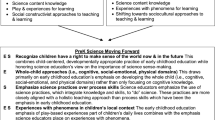Abstract
The goal of this study is to analyze the images of science and scientists in science biographies written for children. We examined 12 biographies of historic and contemporary scientists written for primary/middle school children in relation to three dimensions: characteristics of scientists, nature and process of scientific knowledge, and social processes of science. Biographies of historic scientists were characterized by a relative absence of description of how scientists arrived at their knowledge especially in books addressing younger readers. Biographies of contemporary scientists showed richer descriptions of experimental science with limited attention to connections between evidence and theory. Findings reinforce the need for teachers to guide students in their critical reading of biographies and provide additional resources to help them construct a richer understanding of the nature of science
Similar content being viewed by others
References
I.O. Abimbola S. Baba (1996) ArticleTitle‘Misconceptions and Alternative Conceptions in Science Textbooks: The Role of Teachers as Filters’ American Biology Teacher 58 14–19
D. Allchin (2003) ArticleTitle‘Scientific Myth-Conceptions’ Science Education 87 329–351 Occurrence Handle10.1002/sce.10055
InstitutionalAuthorNameAmerican Association for the Advancement of Science. (1994) Benchmarks for Science Literacy Oxford University Press New York
T. Anderson D. Beck C. West (1994) ArticleTitle‘A Text Analysis of Two Pre-Secondary Science Activities’ Journal of Curriculum Studies 26 163–186
B.B. Armbruster (1992) ArticleTitle‘Science and Reading’ The Reading Teacher 46 346–347
D. Barlow (1991) ArticleTitle‘Children, Books, and Biology’ BioScience 41 166–168
J.A. Bazler D.A. Simonis (1991) ArticleTitle‘Are High School Chemistry Textbooks Gender Fair?’ Journal of Research in Science Teaching 28 353–362
Brandt K. (1983). Marie Curie: Brave Scientist, Troll Associates
B. Cullinan L. Galda (1998) Literature and the Child Harcourt Brace College Publishers New York
Daisey P. (1994). ‘The Use of Trade Books in Secondary Science and Mathematics: Classroom Strategies’. School Science and Mathematics 170–175
D. Darigan M. Tunnell J. Jacobs (2002) Children’s Literature: Engaging Teachers and Children in Good Books Merrill Prentice Hall Upper Saddle River
R. Driver J. Leach R. Millar P. Scott (1996) Young Students Images of Science Open University Press Buckingham
D. Ford (2004a) ‘Highly Recommended Trade Books: Can They Be Used in Inquiry Instruction?’ W. Saul (Eds) Border Crossings: Essays on Literacy and Science. IRA/NSTA Presses Newark 277–290
Ford D. (2004b). in press, ‘Scaffolding Preservice Teachers’ Evaluation of Children’s Science Literature: Attention to Science-focused Genres and Use’. Journal of Science Teacher Education.
Ford D., Tisa L. (2000). ‘Recurring Cultural Themes in Science Books 1970–2000’. in Annual Meeting of the American Educational Research Association, New Orleans
J. Goodall (2001) The Chimpanzees I Love: Saving Their World and Ours Scholastic New York
N. Hanson (1958) Patterns of Discovery Cambridge University Press Cambridge
M. Hodson (1991) ‘Philosophy of Science and Science Education’ M.R. Matthews (Eds) History, Philosophy, and Science Teaching. OISE Press Toronto 19–32
E. Jackson (2002) Looking for Life in the Universe Houghton Mifflin New York
Lamartino A. (1995). Science and Reading. M.S. Thesis, Kean College of New Jersey
J. Lemke (1990) Talking Science Ablex Northwood
I. Lepscky (1992) Albert Einstein Barron’s Hauppauge
I. Lepscky (1993) Marie Curie Barron’s Hauppauge
C.V. Lloyd J.N. Mitchell (1989) ArticleTitle‘Coping With Too Many Concepts in Science Texts’ Journal of Reading 32 542–545
G.M. Madrazo SuffixJr. (1997) ArticleTitle‘Using Trade Books to Teach and Learn Science’ Science and Children 34 20–21
M.R. Matthews (1994) Science Teaching: The Role of History and Philosophy of Science Routledge New York
L. McElroy (2000) Meet My Grandmother: She’s a Deep-Sea Explorer Millbrook Press Brookfield, CT
M. McLoone (1987) George Washington Carver Bridgestone books Mankato
C. Milne (1998) ArticleTitle‘Philosophically Correct Science Stories? Examining The Implications of Heroic Science Stories for School Science’ Journal of Research in Science Teaching 35 175–178 Occurrence Handle10.1002/(SICI)1098-2736(199802)35:2<175::AID-TEA7>3.0.CO;2-P
InstitutionalAuthorNameNational Research Council. (1996) National Science Education Standards National Academy Press Washington
J.F. Newport (1990) ArticleTitle‘Elementary Science Texts: What’s Wrong With Them?’ The Educational Digest 56 68–69
V. Nordstrom (1992) ArticleTitle‘Reducing The Text Burden: Using Children’s Literature and Trade Books in Elementary School Science Education’ Reference Services Review 20 57–70
P. Norris S. (1985) ArticleTitle‘The Philosophical Basis of Observation in Science and Science Education’ Journal of Research in Science Teaching 22 817–833
O’Connor J., Robertson E. (2002). ‘Nicolaus Copernicus’. [Online] Available at http://www-gap.dcs.st-and.ac.uk/∼history/Mathematicians/Copernicus.html
D.A. Roberts (1998) ‘Analyzing School Science Courses: The Concept of Companion Meaning’ D.A. Roberts L. Östman (Eds) Problems of Meaning in Science Curriculum. Teachers College Press New York 5–12
Roseman, J., Kesidou, S., Stern, L. (1997). ‘Identifying Curriculum Materials for Science Literacy. A Project 2061 Evaluation Tool’. in Colloquium: Using the National Science Education Standards to Guide the Evaluation, Selection, and Adaptation of Instructional Materials Held At the National Research Council, November 10–12, 1996, Washington
W. Saul S.A. Jagusch (Eds) (1991) Vital Connections: Children, Science and Books Heinemann Portsmouth
P. Sís (1996) The Starry Messenger Peter Frances Foster Books New York
P. Sís (2003) Tree of Life Frances Foster Books New York
A. Strauss (1987) Qualitative Analysis for Social Scientists Cambridge University Cambridge
G. Walford (1981) ArticleTitle‘Tracking Down Sexism in Physics Textbooks’ Physics Education 16 261–265 Occurrence Handle10.1088/0031-9120/16/5/303
Author information
Authors and Affiliations
Corresponding author
Rights and permissions
About this article
Cite this article
Dagher, Z.R., Ford, D.J. How Are Scientists Portrayed in Children’s Science Biographies?. Sci Educ 14, 377–393 (2005). https://doi.org/10.1007/s11191-004-7933-2
Issue Date:
DOI: https://doi.org/10.1007/s11191-004-7933-2




